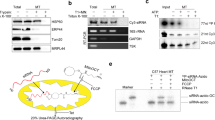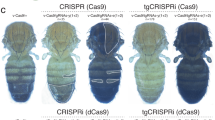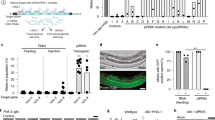Abstract
Sequencing of complete genomes has provided researchers with a wealth of information to study genome organization, genetic instability, and polymorphisms, as well as a knowledge of all potentially expressed genes. The identification of all genes encoded in the human genome opens the door for large-scale systematic gene silencing using small interfering RNAs (siRNAs) and short hairpin RNAs (shRNAs). With the recent development of siRNA and shRNA expression libraries, the application of RNAi technology to assign function to cancer genes and to delineate molecular pathways in which these genes affect in normal and transformed cells, will contribute significantly to the knowledge necessary to develop new and also improve existing cancer therapy.
This is a preview of subscription content, access via your institution
Access options
Subscribe to this journal
Receive 50 print issues and online access
$259.00 per year
only $5.18 per issue
Buy this article
- Purchase on Springer Link
- Instant access to full article PDF
Prices may be subject to local taxes which are calculated during checkout



Similar content being viewed by others
References
Aravind L, Dixit VM and Koonin EV . (2001). Science, 291, 1279–1284.
Aza-Blanc P, Cooper CL, Wagner K, Batalov S, Deveraux QL and Cooke MP . (2003). Mol. Cell, 12, 627–637.
Basson ME, Moore RL, O'Rear J and Rine J . (1987). Genetics, 117, 645–655.
Bender A and Pringle JR . (1991). Mol. Cell Biol., 11, 1295–1305.
Berns K, Hijmans EM, Mullenders J, Brummelkamp TR, Velds A, Heimerikx M, Kerkhoven RM, Madiredjo M, Nijkamp W, Weigelt B, Agami R, Ge W, Cavet G, Linsley PS, Beijersbergen RL and Bernards R . (2004). Nature, 428, 431–437.
Boutros M, Kiger AA, Armknecht S, Kerr K, Hild M, Koch B, Haas SA, Consortium HF, Paro R and Perrimon N . (2004). Science, 303, 832–835.
Brummelkamp TR, Nijman SM, Dirac AM and Bernards R . (2003). Nature, 424, 797–801.
Celera Genomics Project (2001). Science, 291, 1304–1351.
Chen Z and Han M . (2000). Bioessays, 22, 503–506.
Chuaqui RF, Bonner RF, Best CJ, Gillespie JW, Flaig MJ, Hewitt SM, Phillips JL, Krizman DB, Tangrea MA, Ahram M, Linehan WM, Knezevic V and Emmert-Buck MR . (2002). Nat. Genet., 32 (Suppl), 509–514.
Churchill GA . (2002). Nat. Genet., 32 (Suppl), 490–495.
Clemens JC, Worby CA, Simonson-Leff N, Muda M, Maehama T, Hemmings BA and Dixon JE . (2000). Proc. Natl. Acad. Sci., 97, 6499–6503.
Dujon B, Sherman D, Fischer G, Durrens P, Casaregola S, Lafontaine I, De Montigny J, Marck C, Neuveglise C, Talla E, Goffard N, Frangeul L, Aigle M, Anthouard V, Babour A, Barbe V, Barnay S, Blanchin S, Beckerich JM, Beyne E, Bleykasten C, Boisrame A, Boyer J, Cattolico L, Confanioleri F, De Daruvar A, Despons L, Fabre E, Fairhead C, Ferry-Dumazet H, Groppi A, Hantraye F, Hennequin C, Jauniaux N, Joyet P, Kachouri R, Kerrest A, Koszul R, Lemaire M, Lesur I, Ma L, Muller H, Nicaud JM, Nikolski M, Oztas S, Ozier-Kalogeropoulos O, Pellenz S, Potier S, Richard GF, Straub ML, Suleau A, Swennen D, Tekaia F, Wesolowski-Louvel M, Westhof E, Wirth B, Zeniou-Meyer M, Zivanovic I, Bolotin-Fukuhara M, Thierry A, Bouchier C, Caudron B, Scarpelli C, Gaillardin C, Weissenbach J, Wincker P and Souciet JL . (2004). Nature, 430, 35–44.
Elbashir SM, Harborth J, Lendeckel W, Yalcin A, Weber K and Tuschl T . (2001). Nature, 411, 494–498.
Fire A, Xu S, Montgomery MK, Kostas SA, Driver SE and Mello CC . (1998). Nature, 391, 806–811.
Forsburg SL . (2001). Nat. Rev. Genet., 2, 659–668.
Forster T, Roy D and Ghazal P . (2003). J. Endocrinol., 178, 195–204.
Glass B . (1954). Adv. Genet., 6, 95–139.
Hannon GJ . (2002). Nature, 418, 244–251.
Harborth J, Elbashir SM, Bechert K, Tuschl T and Weber K . (2001). J. Cell Sci., 114, 4557–4565.
Hsieh AC, Bo R, Manola J, Vazquez F, Bare O, Khvorova A, Scaringe S and Sellers WR . (2004). Nucleic Acids Res., 32, 893–901.
Huang Q, Raya A, DeJesus P, Chao SH, Quon KC, Caldwell JS, Chanda SK, Izpisua-Belmonte JC and Schultz PG . (2004). Proc. Natl. Acad. Sci., 101, 3456–3461.
International Human Genome Sequencing Consortium (2001). Nature, 409, 860–921.
Jorgensen EM and Mango SE . (2002). Nat. Rev. Genet., 3, 356–369.
Kumar R, Conklin DS and Mittal V . (2003). Genome Res., 13, 2333–2340.
Manche L, Green SR, Schmedt C and Mathews MB . (1992). Mol. Cell Biol., 12, 5238–5248.
Michiels F, van Es H, van Rompaey L, Merchiers P, Francken B, Pittois K, van der Schueren J, Brys R, Vandersmissen J, Beirinckx F, Herman S, Dokic K, Klaassen H, Narinx E, Hagers A, Laenen W, Piest I, Pavliska H, Rombout Y, Langemeijer E, Ma L, Schipper C, Raeymaeker MD, Schweicher S, Jans M, van Beeck K, Tsang IR, van de Stolpe O, Tomme P, Arts GJ and Donker J . (2002). Nat. Biotechnol., 20, 1154–1157.
Mikkers H and Berns A . (2003). Adv. Cancer Res., 88, 53–99.
Minks MA, West DK, Benvin S and Baglioni C . (1979). J. Biol. Chem., 254, 10180–10183.
Montgomery MK . (2004). Methods Mol. Biol., 265, 3–21.
Mousses S, Caplen NJ, Cornelison R, Weaver D, Basik M, Hautaniemi S, Elkahloun AG, Lotufo RA, Choudary A, Dougherty ER, Suh E and Kallioniemi O . (2003). Genome Res., 13, 2341–2347.
Paddison PJ and Hannon GJ . (2002). Cancer Cell, 2, 17–23 . RNA interference: the new somatic cell genetics?.
Paddison PJ and Hannon GJ . (2003). Curr. Opin. Mol. Ther., 5, 217–224.
Paddison PJ, Silva JM, Conklin DS, Schlabach M, Li M, Aruleba S, Balija V, O'Shaughnessy A, Gnoj L, Scobie K, Chang K, Westbrook T, Cleary M, Sachidanandam R, McCombie WR, Elledge SJ and Hannon GJ . (2004). Nature, 428, 427–431.
Shoemaker DD, Lashkari DA, Morris D, Mittmann M and Davis RW . (1996). Nat. Genet., 14, 450–456.
Shuman HA and Silhavy TJ . (2003). Nat. Rev. Genet., 4, 419–431.
Silva JM, Mizuno H, Brady A, Lucito R and Hannon GJ . (2004). Proc. Natl. Acad. Sci., 101, 6548–6552.
Somma MP, Fasulo B, Cenci G, Cundari E and Gatti M . (2002). Mol. Biol. Cell, 13, 2448–2460.
St Johnston D . (2002). Nat. Rev. Genet., 3, 176–188.
Tabara H, Grishok A and Mello CC . (1998). Science, 282, 430–431.
Timmons L and Fire A . (1998). Nature, 395, 854.
Ziauddin J and Sabatini DM . (2001). Nature, 411, 107–110.
Acknowledgements
We thank JP O'Keefe for critical reading and suggestions. JS is supported by a postdoctoral fellowship from the US Army Prostate Cancer Research Program. FVR is a Jane Coffin Childs Memorial Cancer Research Fund fellow. GJH is supported by an Innovator Award from the US Army Breast Cancer Research Program and by grants from the National Institutes of Health.
Author information
Authors and Affiliations
Corresponding author
Rights and permissions
About this article
Cite this article
Silva, J., Chang, K., Hannon, G. et al. RNA-interference-based functional genomics in mammalian cells: reverse genetics coming of age. Oncogene 23, 8401–8409 (2004). https://doi.org/10.1038/sj.onc.1208176
Published:
Issue Date:
DOI: https://doi.org/10.1038/sj.onc.1208176
Keywords
This article is cited by
-
An efficient dsRNA constitutive expression system in Escherichia coli
Applied Microbiology and Biotechnology (2021)
-
Knockdown of GGCT inhibits cell proliferation and induces late apoptosis in human gastric cancer
BMC Biochemistry (2016)
-
Identification and functional analysis of secreted effectors from phytoparasitic nematodes
BMC Microbiology (2016)
-
Therapeutic effects of lentivirus-mediated shRNA targeting of cyclin D1 in human gastric cancer
BMC Cancer (2014)
-
Dicer recognizes the 5′ end of RNA for efficient and accurate processing
Nature (2011)



